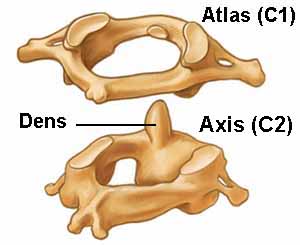Where is your head is as you read this sentence? Is it reaching forward towards the computer monitor or is it back in line with the rest of the spine? If the ears are forward of the shoulders as the eyes reach for the screen the availability of spinal support disappears.
Forward head posture is the most common misalignment that I encounter. Below is a review of the muscles that support the head:
The sub occipital muscles, as the name suggests, are muscles located below the occipital bone. These muscles are the storage center for a great deal of the head and neck tension that so many people feel. They are rectus capitis posterior major and minor & obliquus capitis inferior & superior; one on each side makes a total of eight muscles. The sub occipital muscles connect the head to the spine through two bones at the top of the spine that are vertebrae but very different from the rest of the spinal vertebrae. These bones are called the atlas and the axis.
 The atlas is the bone at the top of the spine and the axis sits directly below the atlas. These two bones allow a greater range of motion than normal vertebrae and are responsible, with the help of the sub occipitals, for extending and rotating the upper spine and the head. The brain stem extends all the way down to the axis connecting these structures to the brain and nervous system.
The atlas is the bone at the top of the spine and the axis sits directly below the atlas. These two bones allow a greater range of motion than normal vertebrae and are responsible, with the help of the sub occipitals, for extending and rotating the upper spine and the head. The brain stem extends all the way down to the axis connecting these structures to the brain and nervous system.
These muscles will only work as designed if our head is successfully on top of the spine. The suboccipital muscles have a number of significant features that set them apart from other muscles. They are the only muscles that are directly connected to the eyes. When your eyes receive information about space and movement, this information is related to the sub occipital muscles and then from the sub occipitals to the rest of the spine. These exchanges happen with every step you take.
The suboccipital muscles are also the only muscles in the body that are directly connected to the spinal cord. The rectus capitus posterior minor, actually sends its connective fibers into the dura matter, a protective layer surrounding the brain and the spinal cord.
Start watching heads and where they are in space. The ears are meant to live back in line with the shoulders and the chin and eye sockets are meant to be level to the ground. The unfortunate tendency is for the head to be forward of the ears and the chin and eye sockets to be slightly elevated.
If this is your posture your body is not in a place to perform at optimal capacity. All of the walking and core work we do is to try and reverse this common misalignment.
What is going on at the back of your neck? Relieving tension and stress in the subocciptal muscles is key to making permanent changes to our movement patterns.

